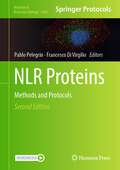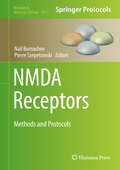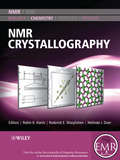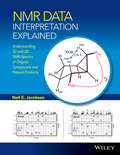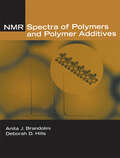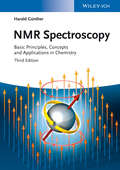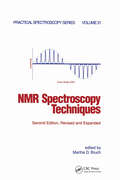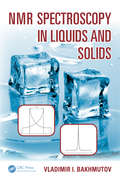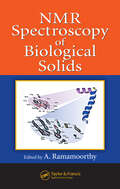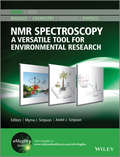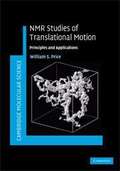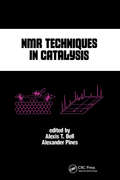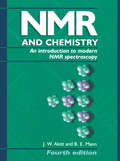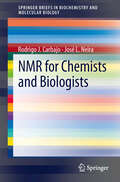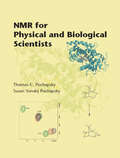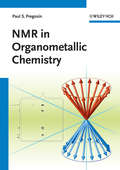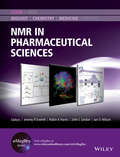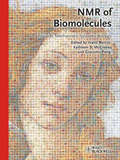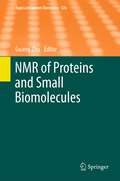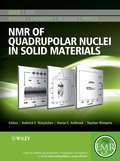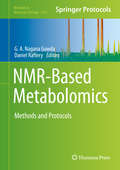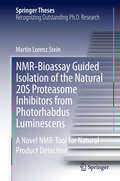- Table View
- List View
NLP: Bullet Guides
by Mo ShapiroOpen this book and you will Know yourself and others Improve relationships Communicate effectively Reframe problems
NLR Proteins: Methods and Protocols (Methods in Molecular Biology #2696)
by Francesco Di Virgilio Pablo PelegrínThis second edition provides a sound basis for the molecular investigation of NLR function in health and disease. Chapters focus on NLR as innate immune receptors, “atypical” inflammasomes, biochemical and novel bioluminescence techniques for the measurement of IL-1b as readout of NLR-based inflammasomes, bioluminescent probe, biochemical and microscopy techniques, techniques to measure caspase-1 activation, cell free systems for the study of inflammasome function, and inflammasome activation. Written in the highly successful Methods in Molecular Biology series format, chapters include introductions to their respective topics, lists of the necessary materials and reagents, step-by-step, readily reproducible laboratory protocols, and key tips on troubleshooting and avoiding known pitfalls. Authoritative and cutting-edge, NLR Proteins: Methods and Protocols, Second Edition aims to be a useful and practical guide to new researcher sand experts looking to expand their knowledge.
NMDA Receptors
by Nail Burnashev Pierre SzepetowskiThis volume explores the latest techniques used by researchers to help them better understand the NMDAR structure-function relations, principles, and rules that govern how NMDARs operate in brain processing. The volume includes a detailed introductory chapter describing the field and is divided into three parts. Topics covered in the volume include: quantification of NMDAR subunit genes expression by qRT-PCR; detection of NMDARs antibodies in encephalitis; recombinant channels in host cells using a fast agonist application system; GluNs detection and functions in microglial cells; and NMDARs as voltage sensors. Written in the highly successful Methods in Molecular Biology series format, chapters include introductions to their respective topics, lists of the necessary materials and reagents, step-by-step, readily reproducible laboratory protocols, and tips on troubleshooting and avoiding known pitfalls. Cutting-edge and practical, NMDA Receptors: Methods and Protocols is a valuable resource that discusses the diversity of the currently-used methods, the importance of NMDARs and their complexity, and the progress that has already been made. This book will be of interest to scientists, clinicians, and industry professionals working in this field.
NMDA Receptors: Methods and Protocols (Methods in Molecular Biology #2799)
by Nail Burnashev Pierre SzepetowskiThis fully updated volume explores N-Methyl-D-aspartate receptors (NMDARs), and the structure-function relations, principles, and rules that govern how NMDARs operate in brain processing under normal and pathological conditions. With chapters from leading laboratories around the world, this book examines the expression and purification of diverse NMDA receptor subtypes, gene targeting and generation of conditional NMDAR mutant mouse lines, studies of NMDARs in zebrafish, electrophysiological studies, NMDARs modeling in silico, drug development with artificial intelligence, and much more. Written for the highly successful Methods in Molecular Biology series, chapters include introductions to their respective topics, lists of the necessary materials and reagents, step-by-step and readily reproducible laboratory protocols, and tips on troubleshooting and avoiding known pitfalls. Authoritative and up-to-date, NMDA Receptors: Methods and Protocols, SecondEdition serves as an ideal guide to the diversity of possible approaches in the field of NMDARs and the progress that has been made in recent years.
NMR Crystallography
by Robin K. Harris Melinda J. Duer Roderick E. WasylishenThe content of this volume has been added to eMagRes (formerly Encyclopedia of Magnetic Resonance) - the ultimate online resource for NMR and MRI.The term "NMR Crystallography" has only recently come into common usage, and even now causes raised eyebrows within some parts of the diffraction community. The power of solid-state NMR to give crystallographic information has considerably increased since the CPMAS suite of techniques was introduced in 1976. In the first years of the 21st century, the ability of NMR to provide information to support and facilitate the analysis of single-crystal and powder diffraction patterns has become widely accepted. Indeed, NMR can now be used to refine diffraction results and, in favorable cases, to solve crystal structures with minimal (or even no) diffraction data. The increasing ability to relate chemical shifts (including the tensor components) to the crystallographic location of relevant atoms in the unit cell via computational methods has added significantly to the practice of NMR crystallography. Diffraction experts will increasingly welcome NMR as an allied technique in their structural analyses. Indeed, it may be that in the future crystal structures will be determined by simultaneously fitting diffraction patterns and NMR spectra.This Handbook is organised into six sections. The first contains an overview and some articles on fundamental NMR topics, followed by a section concentrating on chemical shifts, and one on coupling interactions. The fourth section contains articles describing how NMR results relate to fundamental crystallography concepts and to diffraction methods. The fifth section concerns specific aspects of structure, such as hydrogen bonding. Finally, four articles in the sixth section give applications of NMR crystallography to structural biology, organic & pharmaceutical chemistry, inorganic & materials chemistry, and geochemistry.About EMR Handbooks / eMagRes Handbooks The Encyclopedia of Magnetic Resonance (up to 2012) and eMagRes (from 2013 onward) publish a wide range of online articles on all aspects of magnetic resonance in physics, chemistry, biology and medicine. The existence of this large number of articles, written by experts in various fields, is enabling the publication of a series of EMR Handbooks / eMagRes Handbooks on specific areas of NMR and MRI. The chapters of each of these handbooks will comprise a carefully chosen selection of articles from eMagRes. In consultation with the eMagRes Editorial Board, the EMR Handbooks / eMagRes Handbooks are coherently planned in advance by specially-selected Editors, and new articles are written (together with updates of some already existing articles) to give appropriate complete coverage. The handbooks are intended to be of value and interest to research students, postdoctoral fellows and other researchers learning about the scientific area in question and undertaking relevant experiments, whether in academia or industry.Have the content of this Handbook and the complete content of eMagRes at your fingertips! Visit: www.wileyonlinelibrary.com/ref/eMagResView other eMagRes publications here
NMR Data Interpretation Explained: Understanding 1D and 2D NMR Spectra of Organic Compounds and Natural Products
by Neil E. JacobsenThrough numerous examples, the principles of the relationship between chemical structure and the NMR spectrum are developed in a logical, step-by-step fashion Includes examples and exercises based on real NMR data including full 600 MHz one- and two-dimensional datasets of sugars, peptides, steroids and natural products Includes detailed solutions and explanations in the text for the numerous examples and problems and also provides large, very detailed and annotated sets of NMR data for use in understanding the material Describes both simple aspects of solution-state NMR of small molecules as well as more complex topics not usually covered in NMR books such as complex splitting patterns, weak long-range couplings, spreadsheet analysis of strong coupling patterns and resonance structure analysis for prediction of chemical shifts Advanced topics include all of the common two-dimensional experiments (COSY, ROESY, NOESY, TOCSY, HSQC, HMBC) covered strictly from the point of view of data interpretation, along with tips for parameter settings
NMR Spectra of Polymers and Polymer Additives
by Anita J. Brandolini Deborah D. Hills"Compiles nearly 400 fully assigned NMR spectra of approximately 300 polymers and polymer additives, representing all major clases of materials: polyolefins, styrenics, acrylates, methacrylates, vinyl polymers, elastomers, polyethers, polyesters, polymides, silicones, cellulosics, polyurethanes, plasticizers, and antioxidants."
NMR Spectroscopy
by Harald GüntherNuclear magnetic resonance (NMR) spectroscopy is one of the most powerful and widely used techniques in chemical research for investigating structures and dynamics of molecules. Advanced methods can even be utilized for structure determinations of biopolymers, for example proteins or nucleic acids. NMR is also used in medicine for magnetic resonance imaging (MRI). The method is based on spectral lines of different atomic nuclei that are excited when a strong magnetic field and a radiofrequency transmitter are applied. The method is very sensitive to the features of molecular structure because also the neighboring atoms influence the signals from individual nuclei and this isimportant for determining the 3D-structure of molecules.This new edition of the popular classic has a clear style and a highly practical, mostly non-mathematical approach. Many examples are taken from organic and organometallic chemistry, making this book an invaluable guide to undergraduate and graduate students of organic chemistry, biochemistry, spectroscopy or physical chemistry, and to researchers using this well-established and extremely important technique. Problems and solutions are included.
NMR Spectroscopy Techniques (Practical Spectroscopy)
by Martha BruchThis work elucidates the power of modern nuclear magnetic resonance (NMR) techniques to solve a wide range of practical problems that arise in both academic and industrial settings. This edition provides current information regarding the implementation and interpretation of NMR experiments, and contains material on: three- and four-dimensional NMR;
NMR Spectroscopy in Liquids and Solids
by Vladimir I. BakhmutovNMR Spectroscopy in Liquids and Solids provides an introduction of the general concepts behind Nuclear Magnetic Resonance (NMR) and its applications, including how to perform adequate NMR experiments and interpret data collected in liquids and solids to characterize molecule systems in terms of their structure and dynamics.The book is composed of t
NMR Spectroscopy of Biological Solids
by A. RamamoorthyOver the past decade, a myriad of techniques have shown that solid-state nuclear magnetic resonance (NMR) can be used in a broad spectrum of applications with exceptionally impressive results. Solid-state NMR results can yield high-resolution details on the structure and function of many important biological solids, including viruses, fibril-formin
NMR Spectroscopy: A Versatile Tool for Environmental Research (eMagRes Books)
by Myrna J. Simpson André J. SimpsonThe challenges faced by environmental scientists today are vast, complex, and multi-faceted. For instance, predicting the fate of an environmental pollutant or understanding ecosystem responses to climate change, necessitate a firm understanding of molecular structure and dynamics of environmental media as well as the components that exist and interact within this media. Furthermore, linking information obtained at the molecular-scale to ecosystem-level processes is a major pursuit of modern environmental research. As such, NMR spectroscopy and its scalability from the molecular-scale to the macroscopic-scale, is facilitating rapid growth in environmental science. In addition, the versatility of NMR spectroscopy has resulted in the development and implementation of different types of NMR techniques to examine the structure of various types of environmental samples, living and non-living, as well as the study of critical environmental processes. This comprehensive handbook is a collection of chapters that span from methods to how NMR is used in environmental research to gain insight into various ecosystem properties. It is organized into three parts: Part A focuses on methods used in environmental NMR which span from solution-state to magnetic resonance imaging. Part B emphasizes how NMR spectroscopy plays an essential role in understanding various types of environmental components and related processes, including different forms of organic matter found in soil, water, and air as well as how NMR is used to probe the fate of water, organic pollutants, and metals in the environment. Part C focuses on the growing field of environmental metabolomics which uses NMR as its main discovery platform. This volume highlights the immense potential of NMR spectroscopy to expand our fundamental understanding of environmental processes and how it will continue to do so well into the future. About eMagRes Handbooks eMagRes (formerly the Encyclopedia of Magnetic Resonance) publishes a wide range of online articles on all aspects of magnetic resonance in physics, chemistry, biology and medicine. The existence of this large number of articles, written by experts in various fields, is enabling the publication of a series of eMagRes Handbooks on specific areas of NMR and MRI. The chapters of each of these handbooks will comprise a carefully chosen selection of eMagRes articles. In consultation with the eMagRes Editorial Board, the eMagRes handbooks are coherently planned in advance by specially-selected Editors, and new articles are written to give appropriate complete coverage. The handbooks are intended to be of value and interest to research students, postdoctoral fellows and other researchers learning about the scientific area in question and undertaking relevant experiments, whether in academia or industry. Have the content of this handbook and the complete content of eMagRes at your fingertips! Visit: www.wileyonlinelibrary.com/ref/eMagRes
NMR Studies of Translational Motion
by William S. PriceTranslational motion in solution, either diffusion or fluid flow, is at the heart of chemical and biochemical reactivity. Nuclear Magnetic Resonance (NMR) provides a powerful non-invasive technique for studying the phenomena using magnetic field gradient methods. Describing the physical basis of measurement techniques, with particular emphasis on diffusion, balancing theory with experimental observations and assuming little mathematical knowledge, this is a strong, yet accessible, introduction to the field. A detailed discussion of magnetic field gradient methods applied to Magnetic Resonance Imaging (MRI) is included, alongside extensive referencing throughout, providing a timely, definitive book to the subject, ideal for researchers in the fields of physics, chemistry and biology.
NMR Techniques in Catalysis (Chemical Industries Ser. #55)
by Alexis T. BellThis volume provides an overview of the applications of modern solid-state nuclear magnetic resonance (NMR) techniques to the study of catalysts, catalytic processes, species adsorbed on catalysts and systems relevant to heterogeneous catalysis. It characterizes the structure of catalytic materials and surfaces.
NMR and Chemistry: An introduction to modern NMR spectroscopy, Fourth Edition
by J. W. Akitt B. E. MannKeeping mathematics to a minimum, this book introduces nuclear properties, nuclear screening, chemical shift, spin-spin coupling, and relaxation. It is one of the few books that provides the student with the physical background to NMR spectroscopy from the point of view of the whole of the periodic table rather than concentrating on the narrow applications of 1H and 13C NMR spectroscopy. Aids to structure determination, such as decoupling, the nuclear Overhauser effect, INEPT, DEPT, and special editing, and two dimensional NMR spectroscopy are discussed in detail with examples, including the complete assignment of the 1H and 13C NMR spectra of D-amygdain.The authors examine the requirements of a modern spectrometer and the effects of pulses and discuss the effects of dynamic processes as a function of temperature or pressure on NMR spectra. The book concludes with chapters on some of the applications of NMR spectroscopy to medical and non-medical imaging techniques and solid state chemistry of both I = F1/2 and I > F1/2 nuclei. Examples and problems, mainly from the recent inorganic/organometallic chemistry literature support the text throughout. Brief answers to all the problems are provided in the text with full answers at the end of the book.
NMR for Chemists and Biologists
by Rodrigo J Carbajo Jose Luis NeiraThis book intends to be an easy and concise introduction to the field of nuclear magnetic resonance or NMR, which has revolutionized life sciences in the last twenty years. A significant part of the progress observed in scientific areas like Chemistry, Biology or Medicine can be ascribed to the development experienced by NMR in recent times. Many of the books currently available on NMR deal with the theoretical basis and some of its main applications, but they generally demand a strong background in Physics and Mathematics for a full understanding. This book is aimed to a wide scientific audience, trying to introduce NMR by making all possible effort to remove, without losing any formality and rigor, most of the theoretical jargon that is present in other NMR books. Furthermore, illustrations are provided that show all the basic concepts using a naive vector formalism, or using a simplified approach to the particular NMR-technique described. The intention has been to show simply the foundations and main concepts of NMR, rather than seeking thorough mathematical expressions.
NMR for Physical and Biological Scientists
by Thomas C. Pochapsky Susan PochapskyNuclear Magnetic Resonance spectroscopy is a dynamic way for scientists of all kinds to investigate the physical, chemical, and biological properties of matter. Its many applications make it a versatile tool previously subject to monolithic treatment in reference-style texts. Based on a course taught for over ten years at Brandeis University, this is the first textbook on NMR spectroscopy for a one-semester course or self-instruction. In keeping with the authors' efforts to make it a useful textbook, they have included problems at the end of each chapter. The book not only covers the latest developments in the field, such as GOESY (Gradient Enhanced Overhauser Spectroscopy) and multidimensional NMR, but includes practical examples using real spectra and associated problem sets. Assuming the reader has a background of chemistry, physics and calculus, this textbook will be ideal for graduate students in chemistry and biochemistry, as well as biology, physics, and biophysics. NMR for Physical and Biological Scientists will also be useful to medical schools, research facilities, and the many chemical, pharmaceutical, and biotech firms that offer in-house instruction on NMR spectroscopy.
NMR in Organometallic Chemistry
by Paul S. PregosinThe ultimate guide for anyone working in transition organometallic chemistry and related fields.This book provides the background and practical guidance on how to efficiently work with routine research problems in NMR. It adopts a problem-solving approach with many examples taken from recent literature to show readers how to interpret the data.Perfect for PhD students, postdocs and other newcomers in organometallic and inorganic chemistry, as well as for organic chemists involved in transition metal catalysis.
NMR in Pharmaceutical Science
by Robin K. Harris John C. Lindon Ian D. Wilson Jeremy R. EverettNMR in Pharmaceutical Sciences is intended to be a comprehensive source of information for the many individuals that utilize MR in studies of relevance to the pharmaceutical sector. The book is intended to educate and inform those who develop and apply MR approaches within the wider pharmaceutical environment, emphasizing the toolbox that is available to spectroscopists and radiologists. This book is structured on the key processes in drug discovery, development and manufacture, but underpinned by an understanding of fundamental NMR principles and the unique contribution that NMR (including MRI) can provide. After an introductory chapter, which constitutes an overview, the content is organised into five sections. The first section is on the basics of NMR theory and relevant experimental methods. The rest follow a sequence based on the chronology of drug discovery and development, firstly 'Idea to Lead' then 'Lead to Drug Candidate', followed by 'Clinical Development', and finally 'Drug Manufacture'. The thirty one chapters cover a vast range of topics from analytical chemistry, including aspects involved in regulatory matters and in the prevention of fraud, to clinical imaging studies. Whilst this comprehensive volume will be essential reading for many scientists based in pharmaceutical and related industries, it should also be of considerable value to a much wider range of academic scientists whose research is related to the various aspects of pharmaceutical R&D; for them it will supply vital understanding of pharmaceutical industrial concerns and the basis of key decision making processes.
NMR of Biomolecules: Towards Mechanistic Systems Biology
by Ivano Bertini Giacomo Parigi Kathleen S. McGreevyNMR is one of the most powerful methods for imaging of biomolecules. This book is the ultimate NMR guide for researchers in the biomedical community and gives not only background and practical tips but also a forward looking view on the future of NMR in systems biology.
NMR of Proteins and Small Biomolecules
by Guang ZhuApplication of NMR and Molecular Docking in Structure-Based Drug Discovery, by Jaime L. Stark and Robert Powers NMR as a Unique Tool in Assessment and Complex Determination of Weak Protein-Protein Interactions, by Olga Vinogradova and Jun Qin The Use of Residual Dipolar Coupling in Studying Proteins by NMR, by Kang Chen und Nico Tjandra NMR Studies of Metalloproteins, by Hongyan Li and Hongzhe Sun Recent Developments in 15N NMR Relaxation Studies that Probe Protein Backbone Dynamics, by Rieko Ishima Contemporary Methods in Structure Determination of Membrane Proteins by Solution NMR, by Tabussom Qureshi and Natalie K. Goto Protein Structure Determination by Solid-State NMR, by Xin Zhao Dynamic Nuclear Polarization: New Methodology and Applications, by Kong Hung Sze, Qinglin Wu, Ho Sum Tse and Guang Zhu
NMR of Quadrupolar Nuclei in Solid Materials
by Roderick E. Wasylishen Stephen Wimperis Sharon E. AshbrookThe content of this volume has been added to eMagRes (formerly Encyclopedia of Magnetic Resonance) - the ultimate online resource for NMR and MRI. Over the past 20 years technical developments in superconducting magnet technology and instrumentation have increased the potential of NMR spectroscopy so that it is now possible to study a wide range of solid materials. In addition, one can probe the nuclear environments of many other additional atoms that possess the property of spin. In particular, it is possible to carry out NMR experiments on isotopes that have nuclear spin greater that ½ (i.e. quadrupolar nuclei). Since more that two-thirds of all NMR active isotopes are quadrupolar nuclei, applications of NMR spectroscopy with quadrupolar nuclei are increasing rapidly.The purpose of this handbook is to provide under a single cover the fundamental principles, techniques and applications of quadrupolar NMR as it pertains to solid materials. Each chapter has been prepared by an expert who has made significant contributions to out understanding and appreciation of the importance of NMR studies of quadrupolar nuclei in solids. The text is divided into three sections: The first provides the reader with the background necessary to appreciate the challenges in acquiring and interpreting NMR spectra of quadrupolar neclei in solids. The second presents cutting-edge techniques and methodology for employing these techniques to investigate quadrupolar nuclei in solids. The final section explores applications of solid-state NMR studies of solids ranging from investigations of dynamics, characterizations of biological samples, organic and inorganic materials, porous materials, glasses, catalysts, semiconductors and high-temperature superconductors.About EMR Handbooks / eMagRes Handbooks The Encyclopedia of Magnetic Resonance (up to 2012) and eMagRes (from 2013 onward) publish a wide range of online articles on all aspects of magnetic resonance in physics, chemistry, biology and medicine. The existence of this large number of articles, written by experts in various fields, is enabling the publication of a series of EMR Handbooks / eMagRes Handbooks on specific areas of NMR and MRI. The chapters of each of these handbooks will comprise a carefully chosen selection of articles from eMagRes. In consultation with the eMagRes Editorial Board, the EMR Handbooks / eMagRes Handbooks are coherently planned in advance by specially-selected Editors, and new articles are written (together with updates of some already existing articles) to give appropriate complete coverage. The handbooks are intended to be of value and interest to research students, postdoctoral fellows and other researchers learning about the scientific area in question and undertaking relevant experiments, whether in academia or industry.Have the content of this Handbook and the complete content of eMagRes at your fingertips! Visit: www.wileyonlinelibrary.com/ref/eMagResView other eMagRes publications here
NMR of Quadrupolar Nuclei in Solid Materials (eMagRes Books #7)
by Roderick E. Wasylishen Stephen Wimperis Sharon E. AshbrookThe content of this volume has been added to eMagRes (formerly Encyclopedia of Magnetic Resonance) - the ultimate online resource for NMR and MRI. Over the past 20 years technical developments in superconducting magnet technology and instrumentation have increased the potential of NMR spectroscopy so that it is now possible to study a wide range of solid materials. In addition, one can probe the nuclear environments of many other additional atoms that possess the property of spin. In particular, it is possible to carry out NMR experiments on isotopes that have nuclear spin greater that ½ (i.e. quadrupolar nuclei). Since more that two-thirds of all NMR active isotopes are quadrupolar nuclei, applications of NMR spectroscopy with quadrupolar nuclei are increasing rapidly. The purpose of this handbook is to provide under a single cover the fundamental principles, techniques and applications of quadrupolar NMR as it pertains to solid materials. Each chapter has been prepared by an expert who has made significant contributions to out understanding and appreciation of the importance of NMR studies of quadrupolar nuclei in solids. The text is divided into three sections: The first provides the reader with the background necessary to appreciate the challenges in acquiring and interpreting NMR spectra of quadrupolar neclei in solids. The second presents cutting-edge techniques and methodology for employing these techniques to investigate quadrupolar nuclei in solids. The final section explores applications of solid-state NMR studies of solids ranging from investigations of dynamics, characterizations of biological samples, organic and inorganic materials, porous materials, glasses, catalysts, semiconductors and high-temperature superconductors. About EMR Handbooks / eMagRes Handbooks The Encyclopedia of Magnetic Resonance (up to 2012) and eMagRes (from 2013 onward) publish a wide range of online articles on all aspects of magnetic resonance in physics, chemistry, biology and medicine. The existence of this large number of articles, written by experts in various fields, is enabling the publication of a series of EMR Handbooks / eMagRes Handbooks on specific areas of NMR and MRI. The chapters of each of these handbooks will comprise a carefully chosen selection of articles from eMagRes. In consultation with the eMagRes Editorial Board, the EMR Handbooks / eMagRes Handbooks are coherently planned in advance by specially-selected Editors, and new articles are written (together with updates of some already existing articles) to give appropriate complete coverage. The handbooks are intended to be of value and interest to research students, postdoctoral fellows and other researchers learning about the scientific area in question and undertaking relevant experiments, whether in academia or industry. Have the content of this Handbook and the complete content of eMagRes at your fingertips! Visit: www.wileyonlinelibrary.com/ref/eMagRes View other eMagRes publications here
NMR-Based Metabolomics: Methods and Protocols (Methods in Molecular Biology #2037)
by Daniel Raftery G. A. Nagana GowdaThis book provides broad coverage of nuclear magnetic resonance (NMR) spectroscopy-based methods and applications for the analysis of metabolites in a wide range of biological samples, from biofluids, cells, animal models, human, to plants and foods. The applications range from mechanistic understanding, biomarker discovery, environmental studies, and drug discovery to nutrition, while NMR methods include global, targeted, and isotope tracer-based techniques. Written for the highly successful Methods in Molecular Biology series, chapters include introductions to their respective topics, lists of the necessary materials and reagents, step-by-step, readily reproducible laboratory protocols, and tips on troubleshooting and avoiding known pitfalls. Authoritative and practical, NMR-Based Metabolomics: Methods and Protocols serves as a wealth of information for beginners as well as advanced practitioners and also as stepping stones for further advances in the field of metabolomics.
NMR-Bioassay Guided Isolation of the Natural 20S Proteasome Inhibitors from Photorhabdus Luminescens
by Martin Lorenz SteinMartin Stein's thesis describes a novel methodology for natural product discovery. Due to its high degree of reproducibility, robustness and sensitivity, the technique can be utilized to detect even trace amounts of bioactive substances in heterogeneous matrices such as fermentation broths or crude organic extracts. This research is thus relevant for a large number of researchers working in natural product discovery. Applications of this novel NMR-based approach include suitable environmental triggers for the induction of biosynthetic machineries. The author demonstrates the extraordinary value of this approach by the successful isolation of two potent inhibitors of the pharmaceutically relevant proteasome core particle from the insect pathogen photorhabdus luminescens. This thesis has led to a number of publications in high-impact journals.

